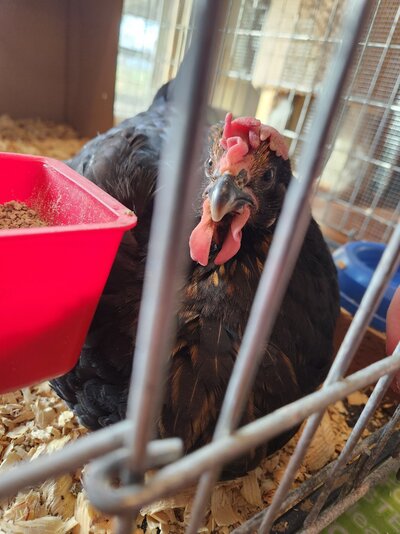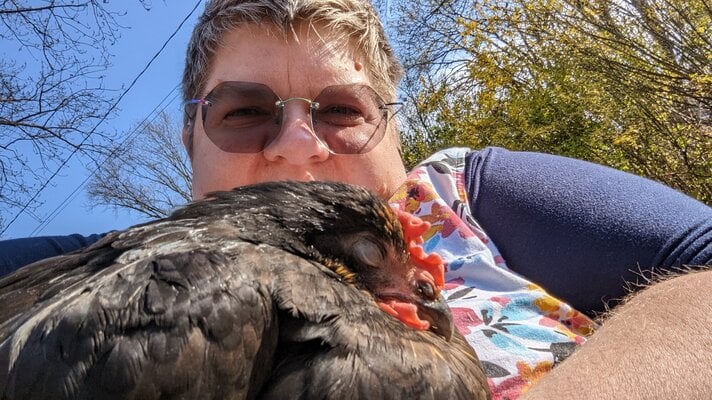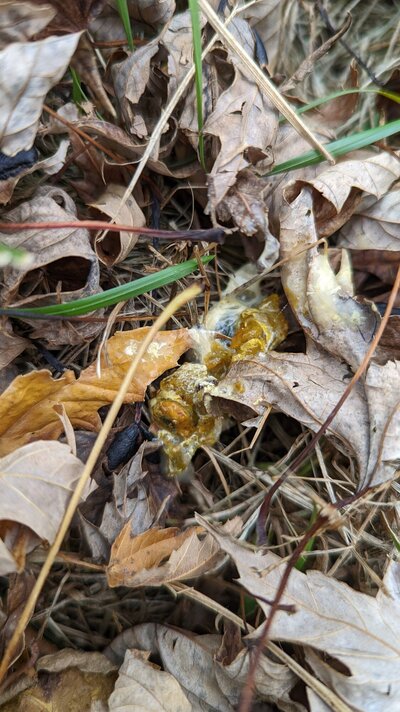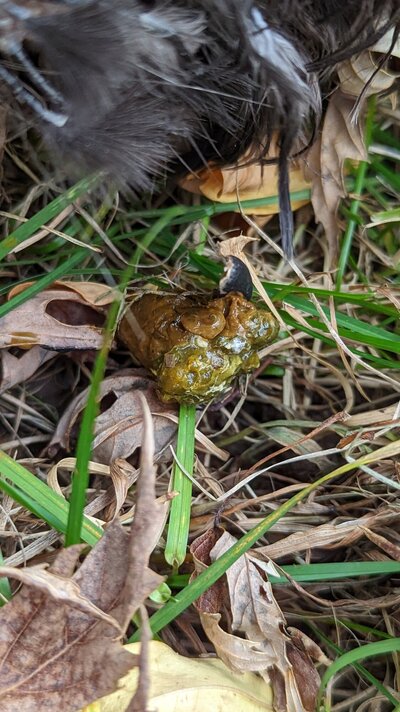mlholmquist
Chirping
- Nov 16, 2020
- 23
- 66
- 79
I'm going to try to provide as much info as I can using the questions from the pinned post - just wondering if others have suggestions for what else to do to help my hen. Sorry this is so long! Thanks for whatever insight and thoughts you might share!
1) What type of bird , age and weight (does the chicken seem or feel lighter or thinner than the others.)
Dottie The Black Knight is a 2 year old Black Sexlink hen that we got as part of an assortment of 8 day-old chicks in 2020. One died on day 2, and one has been rehomed with her chicks to a friend who has room for them to free range, the other 6 are mostly healthy with occasional bumblefoot and one impacted crop last year. Dottie has always been the largest - we haven't weighed them since they moved outdoors at about 2 months old, but she's always had giant dino legs and has always weighed the most by a good pound. She now weighs significantly less than even our smallest hen - our Easter Egger. Her eggs have always been very large, with very thin but solid shells. Until about 6 months ago, she laid VERY bumpy eggs with tons of calcium deposits. We increased the availability of oyster shell, and trimmed her butt feathers, and her eggs are much smoother the last several months.
2) What is the behavior, exactly.
I typically spend an hour or so with the girls for "field trips" a couple times a week, if not more. The last month I haven't been letting them out at all. (My mental health? I'm not sure. But I just haven't.) 7 days ago I sat outside with them for several hours. The girls all stayed closer together than usual, and closer to me. They've been molting since the end of September, so they all look a little ragged. By the end of the field trip, I noticed that Dottie was really limping, and eventually pretty much stopped moving around at all. Then I noticed her comb was "deflated" and pale. When I picked her up, I was shocked at how light she was. We have had several bouts with bumblefoot among our flock, and Dottie is one who seems to be particularly susceptible (probably due to her size from what I've read) so that was the first thing I checked. Yes, she had the telltale scab on the bottom of one foot, and some suspicious smaller spots on the other. Also, one leg is visibly thinner than the other. You can see in the Day 4 feet picture - the larger foot isn't even close to as large as they used to be. She was our thunder thighs!
3) How long has the bird been exhibiting symptoms?
See above.
4) Are other birds exhibiting the same symptoms?
The rest of the flock seems to be ok. Just recovering from molting.
5) Is there any bleeding, injury, broken bones or other sign of trauma.
No bleeding. Yellow tint to both feet/legs - visible in the pictures. A few missing scales on one leg, but they've been gone for several months. Bumblefoot scabs as noted above. I'm not sure how to check for broken bones. No other obvious signs or symptoms, other than she was very jumpy when we touched her feet. (Our flock is very socialized - they all happily jump up into our laps and sit with us for long snuggles and naps.)
6) What happened, if anything that you know of, that may have caused the situation.
Not sure?
7) What has the bird been eating and drinking, if at all.
Since we brought her inside 7 days ago, she has had free access to her crumbles, and ACV water. I have supplemented with a scrambled egg a couple of times, which she snarfs up. And she gets mealworms as a treat, in her food dish to encourage her to eat her crumbles too. It seemed like she wasn't eating her crumbles, so the last 2 days I've been making up a mash of crumbles, warm water, with additives (see #9 below). She has not laid an egg in 8-9 days. She is coming through her molt, and her tail feathers are visibly longer as of today.
8) How does the poop look? Normal? Bloody? Runny? etc.
Poop is very runny. No blood. Dark green contained in lots of clearish fluid. She has always had a very poopy butt. We clean her off occasionally, and this spring trimmed away all of the feathers on her bum.
9) What has been the treatment you have administered so far?
Foot baths every other day: warm water, epsom salts, 5 drops CBD oil, and 5 drops VetRx for 30 minutes
Wrapped feet: packed with triple antibiotic ointment, wrapped with non-stick gauze and self-adhesive wrap
Oral treatments: 2-3 drops of CBD oil + 1.5cc Nutridrench + 2-3 drops of VetRx mixed in mash or with scrambled egg. The first couple of days we syringe-fed the Nutridrench
10 ) What is your intent as far as treatment? For example, do you want to treat completely yourself, or do you need help in stabilizing the bird til you can get to a vet?
We will do whatever treatment is necessary. We cannot afford vet treatment for our flock. We have strong stomachs and have tackled impacted crop surgery, bumblefoot surgery, and recovery care over the last 2 years. Never knew we were this capable, but I'm very proud of all that we've been able to do for our flock!
11) If you have a picture of the wound or condition, please post it. It may help.
See attachments.
12) Describe the housing/bedding in use
Our 6 remaining girls (Black Sexlink, 2 Barred Rocks, Easter Egger, Red something, and Brown/Black something) have an 8'x20' run and 4'x8' coop, both with sand as the base. We have stairstep roosts that are 2x4s laid flat (wide side up), about 6-8 inches apart. Nesting boxes have natural nesting pads in them. Hanging feeder. Hanging nipple waterer. In our "hospital cage" inside the house, Dottie has shavings for bedding, a box for snuggling, free access to crumbles and an open water dish.
1) What type of bird , age and weight (does the chicken seem or feel lighter or thinner than the others.)
Dottie The Black Knight is a 2 year old Black Sexlink hen that we got as part of an assortment of 8 day-old chicks in 2020. One died on day 2, and one has been rehomed with her chicks to a friend who has room for them to free range, the other 6 are mostly healthy with occasional bumblefoot and one impacted crop last year. Dottie has always been the largest - we haven't weighed them since they moved outdoors at about 2 months old, but she's always had giant dino legs and has always weighed the most by a good pound. She now weighs significantly less than even our smallest hen - our Easter Egger. Her eggs have always been very large, with very thin but solid shells. Until about 6 months ago, she laid VERY bumpy eggs with tons of calcium deposits. We increased the availability of oyster shell, and trimmed her butt feathers, and her eggs are much smoother the last several months.
2) What is the behavior, exactly.
I typically spend an hour or so with the girls for "field trips" a couple times a week, if not more. The last month I haven't been letting them out at all. (My mental health? I'm not sure. But I just haven't.) 7 days ago I sat outside with them for several hours. The girls all stayed closer together than usual, and closer to me. They've been molting since the end of September, so they all look a little ragged. By the end of the field trip, I noticed that Dottie was really limping, and eventually pretty much stopped moving around at all. Then I noticed her comb was "deflated" and pale. When I picked her up, I was shocked at how light she was. We have had several bouts with bumblefoot among our flock, and Dottie is one who seems to be particularly susceptible (probably due to her size from what I've read) so that was the first thing I checked. Yes, she had the telltale scab on the bottom of one foot, and some suspicious smaller spots on the other. Also, one leg is visibly thinner than the other. You can see in the Day 4 feet picture - the larger foot isn't even close to as large as they used to be. She was our thunder thighs!
3) How long has the bird been exhibiting symptoms?
See above.
4) Are other birds exhibiting the same symptoms?
The rest of the flock seems to be ok. Just recovering from molting.
5) Is there any bleeding, injury, broken bones or other sign of trauma.
No bleeding. Yellow tint to both feet/legs - visible in the pictures. A few missing scales on one leg, but they've been gone for several months. Bumblefoot scabs as noted above. I'm not sure how to check for broken bones. No other obvious signs or symptoms, other than she was very jumpy when we touched her feet. (Our flock is very socialized - they all happily jump up into our laps and sit with us for long snuggles and naps.)
6) What happened, if anything that you know of, that may have caused the situation.
Not sure?
7) What has the bird been eating and drinking, if at all.
Since we brought her inside 7 days ago, she has had free access to her crumbles, and ACV water. I have supplemented with a scrambled egg a couple of times, which she snarfs up. And she gets mealworms as a treat, in her food dish to encourage her to eat her crumbles too. It seemed like she wasn't eating her crumbles, so the last 2 days I've been making up a mash of crumbles, warm water, with additives (see #9 below). She has not laid an egg in 8-9 days. She is coming through her molt, and her tail feathers are visibly longer as of today.
8) How does the poop look? Normal? Bloody? Runny? etc.
Poop is very runny. No blood. Dark green contained in lots of clearish fluid. She has always had a very poopy butt. We clean her off occasionally, and this spring trimmed away all of the feathers on her bum.
9) What has been the treatment you have administered so far?
Foot baths every other day: warm water, epsom salts, 5 drops CBD oil, and 5 drops VetRx for 30 minutes
Wrapped feet: packed with triple antibiotic ointment, wrapped with non-stick gauze and self-adhesive wrap
Oral treatments: 2-3 drops of CBD oil + 1.5cc Nutridrench + 2-3 drops of VetRx mixed in mash or with scrambled egg. The first couple of days we syringe-fed the Nutridrench
10 ) What is your intent as far as treatment? For example, do you want to treat completely yourself, or do you need help in stabilizing the bird til you can get to a vet?
We will do whatever treatment is necessary. We cannot afford vet treatment for our flock. We have strong stomachs and have tackled impacted crop surgery, bumblefoot surgery, and recovery care over the last 2 years. Never knew we were this capable, but I'm very proud of all that we've been able to do for our flock!
11) If you have a picture of the wound or condition, please post it. It may help.
See attachments.
12) Describe the housing/bedding in use
Our 6 remaining girls (Black Sexlink, 2 Barred Rocks, Easter Egger, Red something, and Brown/Black something) have an 8'x20' run and 4'x8' coop, both with sand as the base. We have stairstep roosts that are 2x4s laid flat (wide side up), about 6-8 inches apart. Nesting boxes have natural nesting pads in them. Hanging feeder. Hanging nipple waterer. In our "hospital cage" inside the house, Dottie has shavings for bedding, a box for snuggling, free access to crumbles and an open water dish.
Attachments
-
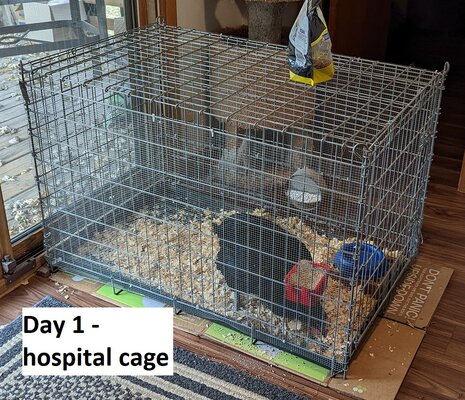 Day1-HospitalCage.jpg710.8 KB · Views: 41
Day1-HospitalCage.jpg710.8 KB · Views: 41 -
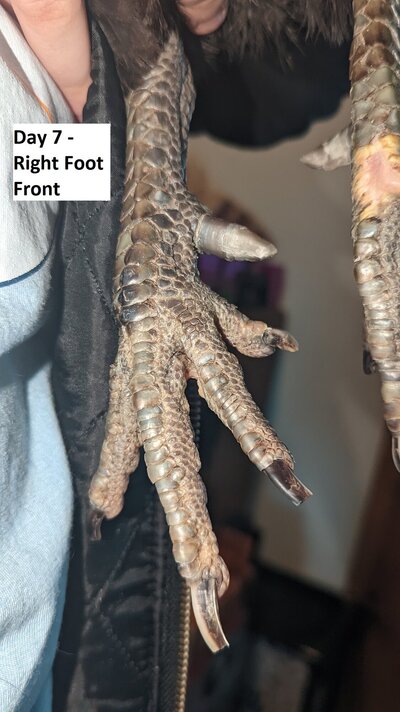 Day7-rightfoot-front.jpg373.1 KB · Views: 7
Day7-rightfoot-front.jpg373.1 KB · Views: 7 -
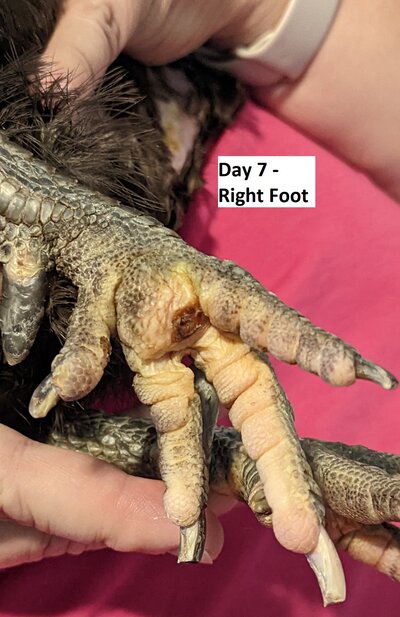 Day7-rightfoot.jpg644.6 KB · Views: 9
Day7-rightfoot.jpg644.6 KB · Views: 9 -
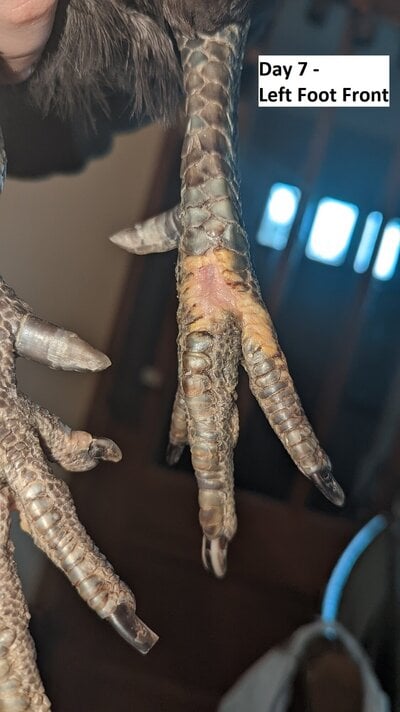 Day7-leftfoot-front.jpg303.1 KB · Views: 9
Day7-leftfoot-front.jpg303.1 KB · Views: 9 -
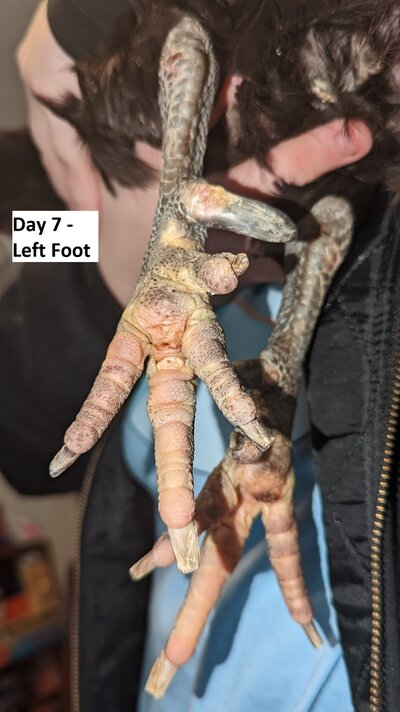 Day7-leftfoot.jpg306.4 KB · Views: 9
Day7-leftfoot.jpg306.4 KB · Views: 9 -
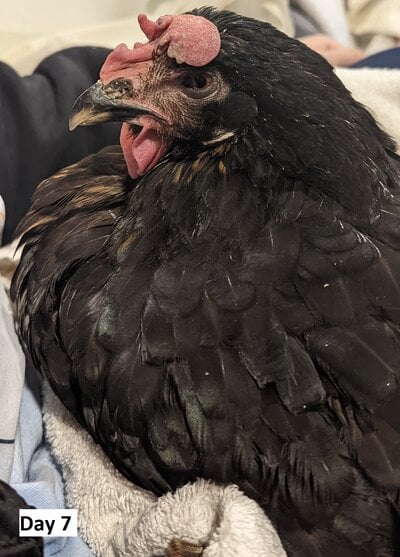 Day7.jpg607.7 KB · Views: 8
Day7.jpg607.7 KB · Views: 8 -
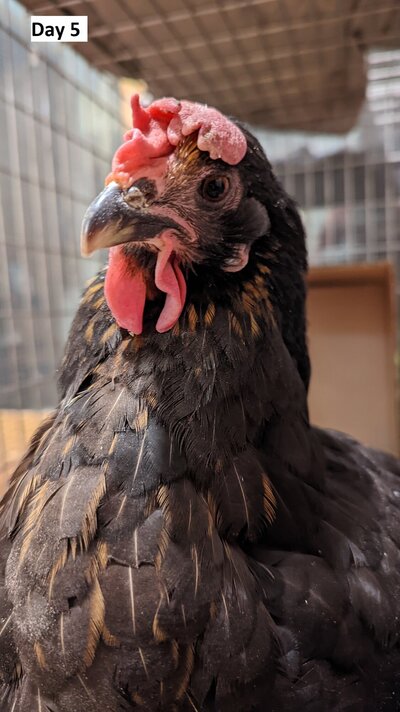 Day5.jpg327.4 KB · Views: 8
Day5.jpg327.4 KB · Views: 8 -
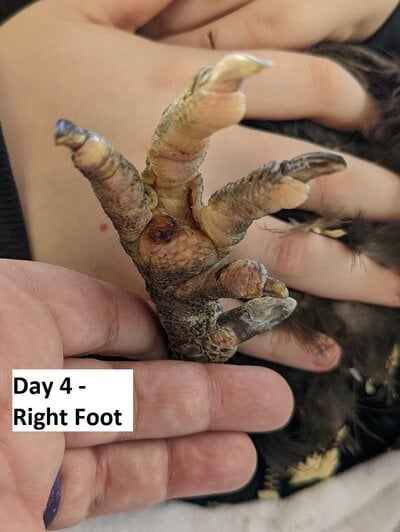 Day4-rightfoot.jpg334.6 KB · Views: 8
Day4-rightfoot.jpg334.6 KB · Views: 8 -
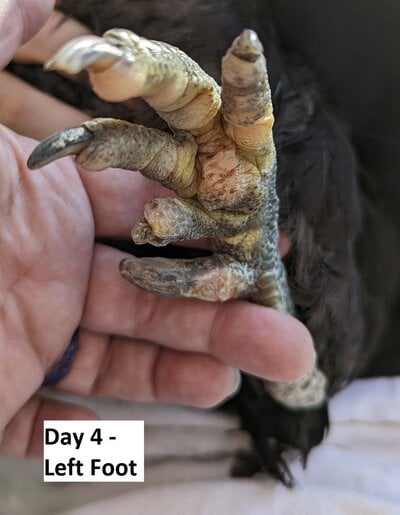 Day4-leftfoot.jpg330.1 KB · Views: 8
Day4-leftfoot.jpg330.1 KB · Views: 8 -
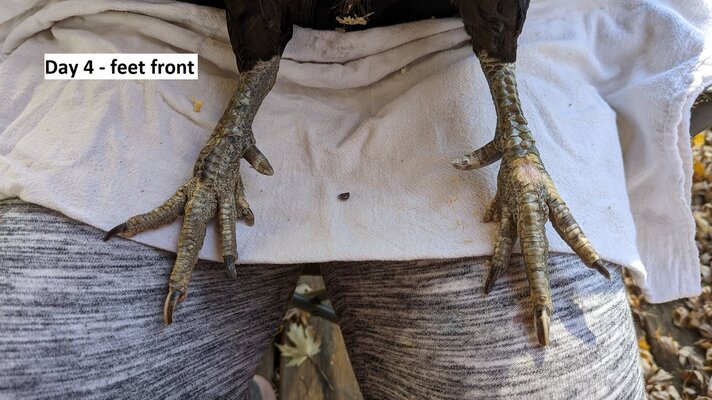 Day4-feet.jpg625.3 KB · Views: 8
Day4-feet.jpg625.3 KB · Views: 8 -
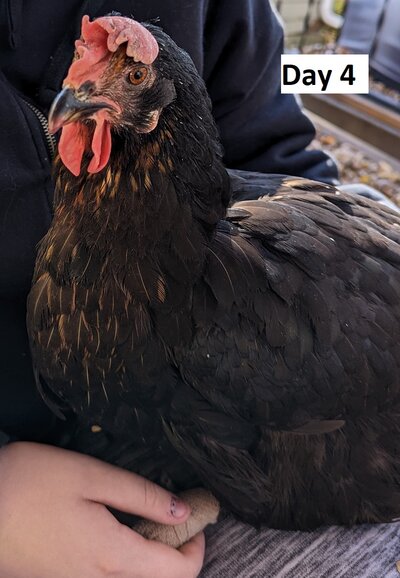 Day4.jpg332.3 KB · Views: 8
Day4.jpg332.3 KB · Views: 8 -
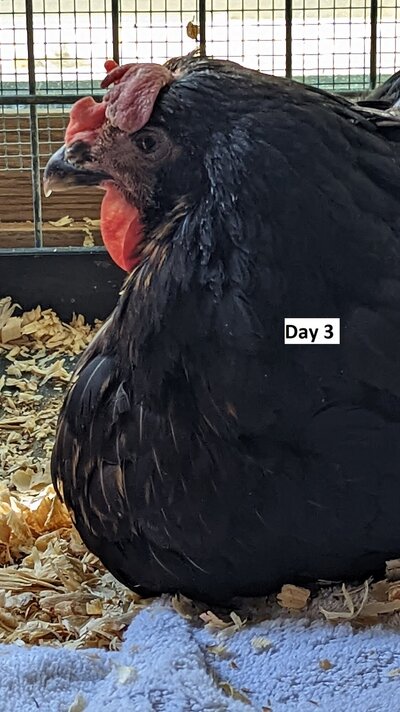 Day3.jpg347.1 KB · Views: 6
Day3.jpg347.1 KB · Views: 6 -
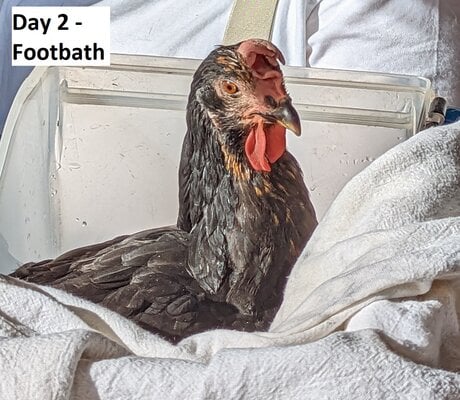 Day2-Footbath.jpg493.2 KB · Views: 7
Day2-Footbath.jpg493.2 KB · Views: 7




 I believe we called them "hershey squirts" when I was a kid. LOL!
I believe we called them "hershey squirts" when I was a kid. LOL!